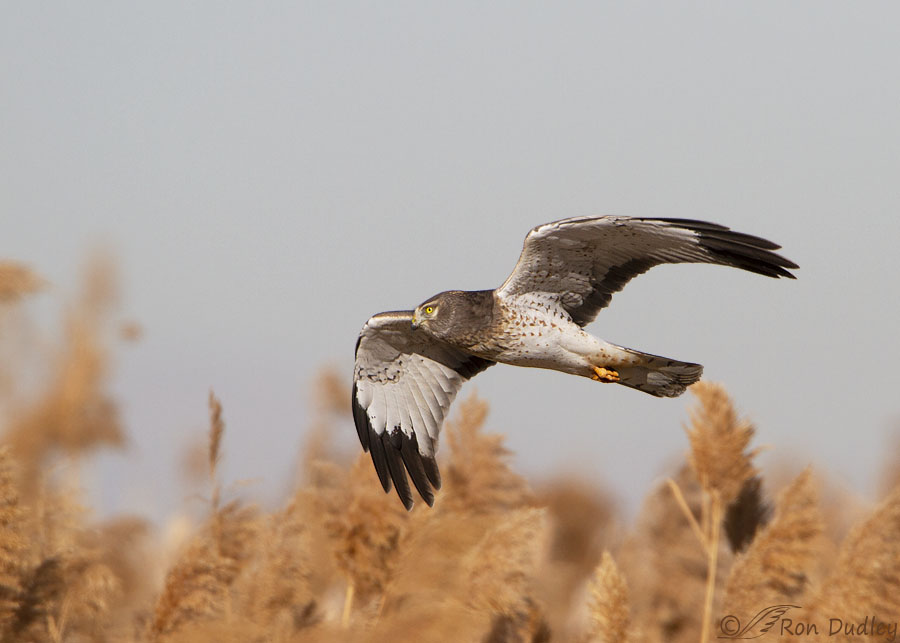I’ve mentioned before how much I like backgrounds like this one. Here’s another example.

1/3200, f/7.1, ISO 400, Canon 7D, Canon EF 500mm f/4L IS II USM + EF 1.4 III Extender, not baited, set up or called in
This is a photo from my archives I’ve never posted before, taken on December 4, 2009 at Farmington Bay WMA. This male Northern Harrier, the fabled “Gray Ghost”, was hunting the edges of a phragmites stand as they so often do at Farmington.
I love masses of these relatively dark and fluffy phragmites seed plumes in the backgrounds of my photos, especially photos of harriers and Barn Owls in flight. Here they anchor the hawk in the frame as he flies mostly above them and their color complements some of his ventral plumage colors and even those of his feet. A week ago I published a photo of a male harrier in flight with the much lighter vertical stems of phragmites in the background but frankly I like these darker plumes much better than those lighter colored, tightly packed and relatively unattractive vertical stems.
But then I’m attracted to harriers no matter their context. I never saw them growing up on the Montana farm (that I remember) so my first real introduction to the “Marsh Hawk” was at Bear River MBR in 1969 while I was taking an ornithology class during my senior year in college.
It’s been a 50 year love affair and I’m still hooked.
Ron


WoW!….really like this one. 🙂
Tim
Lovely photo, I saw many harriers today but no one was cooperative for photos. I wish my windshield folded down like the old Jeep’s. Every time I tried to turn the least bit sideways with the car the birds spooked. Long drive for a few mediocre heron shots!
Yup, birds don’t like it when your car begins to turn. They also don’t like it when you go down the road a few hundred yards and then turn around and come back for them. They’ll let you pass close by them the first time but often not the second.
Have I ever said it? – Bird photography ain’t easy! 🙂
I can see why you like these backgrounds…This one totally compliments the photo (the really really nice photo) of the harrier….it emphasizes how important the background of a photo can be…. enhancing or detracting from it…thanks again Ron, for the photo and the lesson.
“it emphasizes how important the background can be”
I absolutely agree, Steve. I often think the background/setting is at least as important as the subject.
What a glorious sight.
I am not at all surprised your love affair has reached its golden anniversary.
I hope it continues for many more years to come. Thanks, EC.
And so say all of us.
🙂
The phragmites really does add a rich background. Great shot of the ventral surface of the Harrier, as they seem to so often fly close to the ground. That foot looks a bit bumpy; most likely my imagination.
I think the foot looks ok, but I see what you mean, Lyle.
Really nice photo! I love when I get a chance to see these beautiful birds. Luckily they come around these parts pretty often!
Thanks, Joanne.
Wow, he’s a beaut! The eye, nares, and feet really pop amidst all the browns and beiges.
Hope you have a low pain day today!
Thank you, Marty. Me too.
Gorgeous shot, Ron! The darker Phragmites to compliment the color of the harrier and give context to the photo. 🙂 Even as an invasive species they are helpful in some ways…….. 😉 If we had the harriers around when I was young I didn’t realize what they were and, even earlier this year, at a quick glance I thought it was a gull….. Doing the big chinook thing to be followed by rain/possibly a flash freeze/ and snow…… 🙁 Our turn I guess after a VERY mild fall…..
When I mentioned in my post that I hadn’t seen them on the farm I wondered if you’d seen them up there. So maybe our collective memory is right!
I have a bit of a love/hate relationship with phrags. They sure cause a lot of problems in the marshes but I think they’re often lovely in bird photos and they certainly provide some valuable habitat and even food for some bird species. They’ve cleared a lot of them out at Farmington and that makes it more difficult to photograph some raptors in flight, including harriers and Barn Owls in winter. Thanks, Judy.